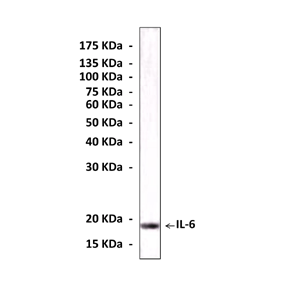Anti-IL-6: Mouse Interleukin-6 Antibody |
 |
BACKGROUND The cytokine interleukin 6 (IL-6), a proinflammatory cytokine, is a major mediator of the host response to injury and infection. IL-6 stimulates the production of "acute phase" plasma proteins by the liver; enhances B- and T-cell proliferation; and enhances B-cell, T-cell, and macrophage activation. In addition, IL-6 also acts on hematopoietic stem cells, nerve cells, keratinocytes, renal mesangial cells, megakaryocytes and myeloma cells. Since antibody production, hematopoiesis, and acute phase reactions are three major responses against infection, inflammation, and tissue injury, IL-6 may have a central role in host defense mechanisms. Furthermore, IL-6 is produced by a number of different cell types such as fibroblasts, macrophages, endothelial cells, and keratinocytes in response to induction by a variety of stimuli, which include other cytokines such as interleukin 1 (IL-1), tumor necrosis factor, and platelet-derived growth factor.1 Deregulated overproduction of IL-6 has been found to play pathological roles in chronic inflammatory diseases such as rheumatoid arthritis, Castleman’s disease, juvenile idiopathic arthritis and Crohn’s disease. IL-6 can facilitate autoimmune phenomena, amplify acute inflammation and promote the evolution into a chronic inflammatory state. In addition, it is a major promoter of bone resorption in pathological conditions. In particular, IL-6 has a pivotal role in synovitis, bone erosions and in the systemic features of inflammation. Humanized anti-IL-6 receptor antibody has been developed as a therapeutic agent for these diseases, and therapeutic benefits have been revealed in clinical studies.2
Signaling by IL-6 involves two pathways: Janus-associated kinases (JAK) and signal transducers and activators of transcription (STAT 3) are activated in the first pathway while the second pathway involves the activation of mitogen-activated protein kinases (MAPK).3 The IL-6 classic signaling was via membrane bound receptor (mIL-6R). In addition, IL-6 signaling can also be mediated by soluble IL-6R (sIL-6R) thereby activating cells that do not express membrane bound IL-6R. This process has been named trans-signaling. Trans-signaling allows IL-6 to affect cells that do not express IL-6R, including many synovial cells.4
Signaling by IL-6 involves two pathways: Janus-associated kinases (JAK) and signal transducers and activators of transcription (STAT 3) are activated in the first pathway while the second pathway involves the activation of mitogen-activated protein kinases (MAPK).3 The IL-6 classic signaling was via membrane bound receptor (mIL-6R). In addition, IL-6 signaling can also be mediated by soluble IL-6R (sIL-6R) thereby activating cells that do not express membrane bound IL-6R. This process has been named trans-signaling. Trans-signaling allows IL-6 to affect cells that do not express IL-6R, including many synovial cells.4
REFERENCES
1. Akira, S. et al: FASEB J. 4:2860-7, 1990
2. Nishimoto, N. & Kishimoto, T.: Curr. Opin. Pharm. 4:386-91, 2004
3. Heinrich, P.C. et al: Biochem J. 374: 1–20, 2003
4. Jones, S.A. et al: J. Interferon Cytokine Res. 25:241-53, 2005
2. Nishimoto, N. & Kishimoto, T.: Curr. Opin. Pharm. 4:386-91, 2004
3. Heinrich, P.C. et al: Biochem J. 374: 1–20, 2003
4. Jones, S.A. et al: J. Interferon Cytokine Res. 25:241-53, 2005
Products are for research use only. They are not intended for human, animal, or diagnostic applications.
Параметры
Cat.No.: | CP10325 |
Antigen: | Raised against recombinant human IL-6 fragments expressed in E. coli. |
Isotype: | Mouse IgG1 |
Species & predicted species cross- reactivity ( ): | Human, Mouse, Rat |
Applications & Suggested starting dilutions:* | WB 1:1000 IP 1:50 IHC n/d ICC n/d FACS n/d |
Predicted Molecular Weight of protein: | 19 kDa |
Specificity/Sensitivity: | Detects endogenous IL-6 proteins without cross-reactivity with other family members. |
Storage: | Store at -20°C, 4°C for frequent use. Avoid repeated freeze-thaw cycles. |
*Optimal working dilutions must be determined by end user.
Документы
Информация представлена исключительно в ознакомительных целях и ни при каких условиях не является публичной офертой








